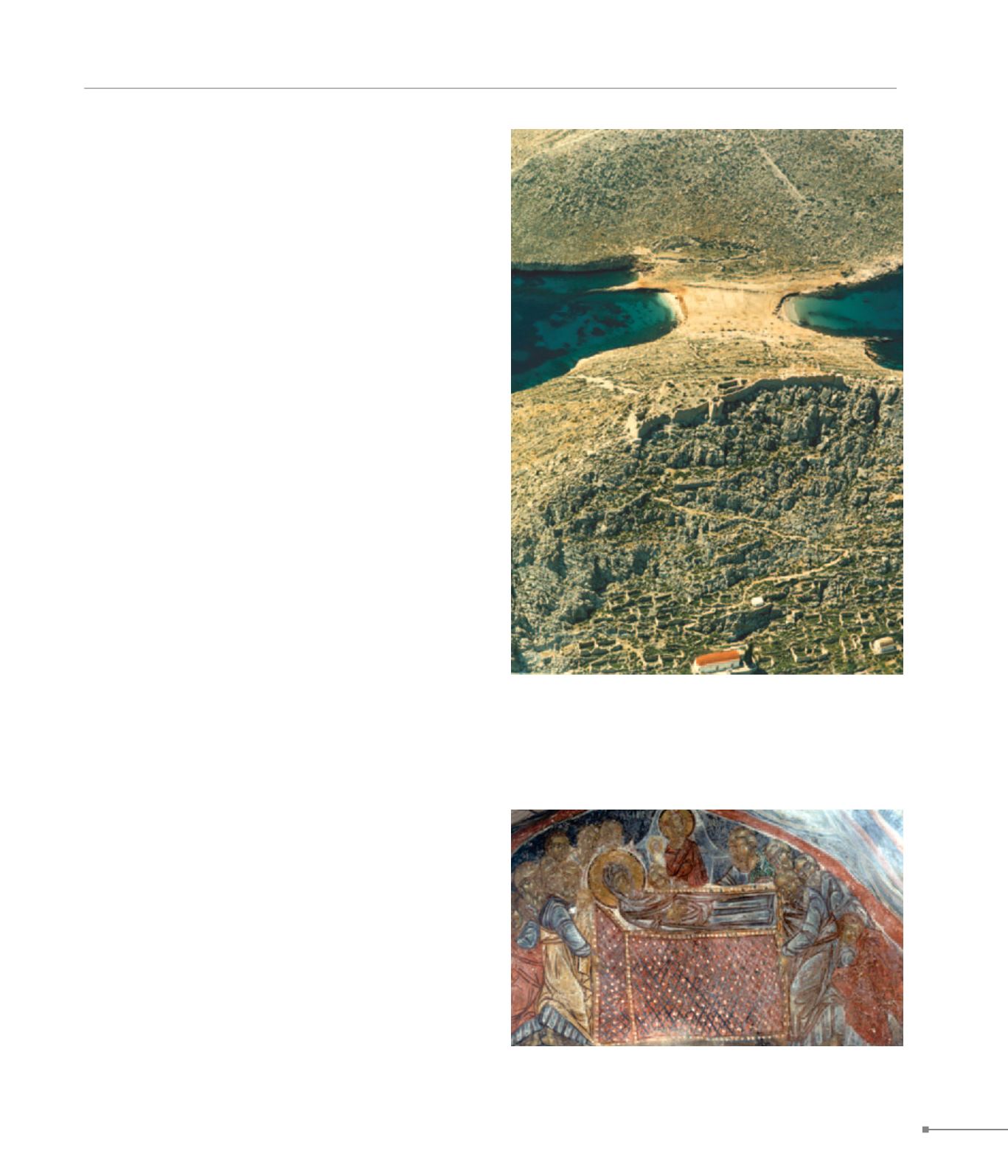
Chalki.
Chalki.
THE ISLANDS
405
608. Chalki, Panagia Hodegetria or Enniameritissa, wall painting (Χάλκη,
Παναγία Οδηγήτρια ή Εννιαμερίτισσα, τοιχογραφία)
608. Chalki, settlement and castle of Saint Nicholas (Χάλκη, ο οικισμός
και το κάστρο του Αγίου Νικολάου)
14th c.), as well as on the ground floor of the catholicon of the
Archangel Michael Roukouniotes monastery (4) and on the
external wall-painted conch of its N section date from the time
of Knights Hospitaller rule (15th c.). Part of the castle at Chorio
(2) – belonging to the island’s 14th-15th c. fortifications – sur-
vives at the site of the ancient citadel. The castle was repaired
by the Knights, as indicated by the coat of arms of Emery
D’Amboise, grand master of the Hospitallers (1503-12), which
mentions the date 1507. This is embedded in the S side of the
castle, where it survives at a good height. The Panagia church,
built within the castle, features on its façade embedded coats
of arms of Zacosta, grand master of the Knights (1461-7) and
of de Milly (grand master 1454-61), as well as an inscription
with the date 10 April 1456. The original location of these coats
of arms was in the castle, at the internal Siderini gate.
608.
Chalki.
The present-day coastal village of Emporios (also known as
Imporios) was first inhabited in the Early Christian period, as
attested by a fragment of a mosaic floor in the E of Saint Ni-
cholas cathedral (7), as well as by architectural sculptures at
the Aghia Kyriake site at Zyes on the outskirts of the village.
Another area that was inhabited was Kefali (3), located at the
island of Chalki’s NW tip, where remains of an Early Chris-
tian basilica survive. Already from the Early Christian period
the island was home to hermits, as proved by the rare wall-
paintings that have been found at Askitario (8), a hermit cell in
a rock cave at a steep location on the NE coast of the island (a
site also known as Kellia).
Many small churches dating from the time of Byzantine and
Knights Hospitaller rule are scattered throughout the island.
From the 35 churches that have been listed, almost half retain
wall-paintings. These are size-restricted, barrel-vaulted, sin-
gle-nave churches, most of which are located at the medieval
village of Chorio and in the surrounding area. Today deserted,
Chorio (1) was invisible from the sea, so it could be protected
from pirates. It stretched up the slope of a hill, on the top of
which stands a Knights’ castle bearing the coat of arms of D’
Aubusson (1476-80). Within the castle lies the nearly ruined
church of Saint Nicholas, the largest medieval church on the
island, with wall-paintings from the 15th c. From the remaining
chapels it is worth mentioning the following: Panagia Hode-
getria or Enniameritissa (2), which preserves its wall-painted
decoration and is dated to 1367 according to an inscription;
Panormitis at Plagia (5) preserving two layers of frescoes (13th
and 14th c.); the Stavros church (Holy Cross) at Plekti (14th
c.?) (6); Saint Andrew at Antramasos (4), as well as Aghios
Zacharias at Phoiniki (9), whose wall-paintings (late 14th c.)
have been removed and are exhibited at Panagia in-the-Castle
in Rhodes.


